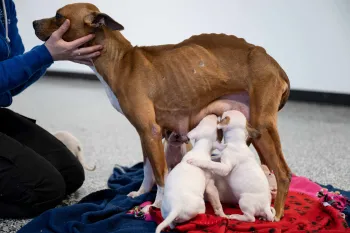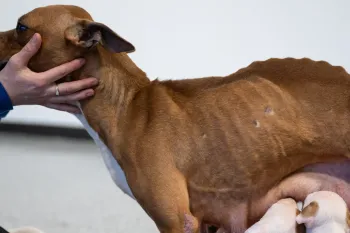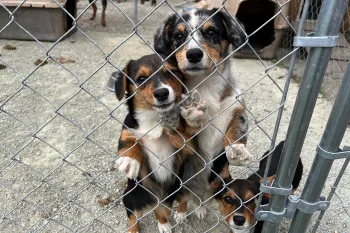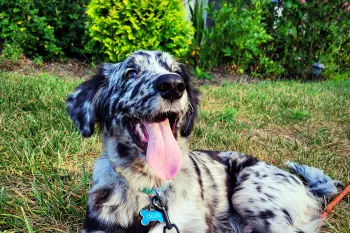Dogfighting creates and perpetuates a life cycle of abuse. Dogs bred, conditioned and forced to fight one another often die of dehydration, infection, blood loss, exhaustion or shock hours or even days after the fight, and mother dogs are used as breeding machines to produce more victims for these horrific spectacles. We worked to ensure that dogfighting is banned across the U.S. and now we’re focused on enforcing these bans. When asked to assist law enforcement in a bust of an alleged dogfighting ring earlier this year, our rescue team seized the opportunity to interrupt this cycle of violence to give so many dogs a chance at loving homes. One of these dogs was Joan Jett, who was nursing six puppies when we found her. Here, Lindsay Hamrick, our director of shelter outreach and engagement, who became Joan Jett’s foster, follows up on Joan Jett’s story.
At the scene, I still remember kneeling down to gently introduce myself and then carefully lifting her up on the table for a veterinary exam. I could feel each of her ribs and see each bone of her spine. The veterinarian noted her emaciation, a cracked tooth and some scarring on her body. We moved her onto a warm transport vehicle with her nursing puppies. Joan Jett was one of over 120 dogs we rescued from an alleged dogfighting operation. (The rescue team named each dog after musicians.) I didn’t realize at the time that I would see her again.
A police officer on scene asked me, “How do you not take them all home?”
“Impulse control,” I replied.
I would laugh at my response a few weeks later when my local animal shelter, a Humane Society of the United States shelter partner, chose Joan Jett and her now-weaned puppies for its adoption program. My partner and I immediately offered to foster her.
As with each of our previous foster animals, we moved at her pace, providing a decompression period while our two resident dogs got to know the new arrival. They’re used to this by now. They’ve helped dozens of dogs and cats (and the occasional orphaned lamb) recover from trauma or illness. Joan Jett needed to learn about living in a house for the first time: how to walk up and down stairs, how comfortable a couch is, how to stare directly into my eyes (as if into my very soul) from her crate so I would cave and bring her into bed (she was a natural at this one). For two weeks, I would get down on all fours, showing her how to take each step upstairs slowly. She looked on skeptically, almost as if judging me to be utterly ridiculous, until one day, our dog Finn walked up the stairs ahead of her, and Joan Jett easily trotted along behind. Dogs are often the best teachers for other dogs.
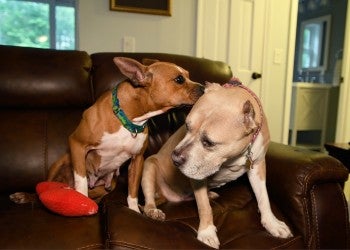
Kyra Hunsicker/The HSUS
From the start, our only goal was to teach her she was safe. That she could play with other dogs and not get hurt, that our kids are, for her purposes, just walking treat dispensers, that she could have an accident on the floor without any drama from us. Two months later, she was healthy enough to be spayed, and soon after that she found a wonderful home. She now lives with two dog friends, two cats and a flock of chickens.
Every animal has a story. Some, like Joan Jett’s, remind us of the heights of animal cruelty and its reverberating trauma. That she came through and learned to love and trust is truly astounding. But other animals have stories that, for better or worse, do not grab enough attention for headlines. That is the case with countless others in animal shelters who have been separated from their families because of systemic failures to support people with pets and preserve the human-animal bond.
The reasons some pets end up being surrendered to shelters often lie in difficulties families have in finding pet-inclusive housing or access to affordable veterinary care. Solving these problems will take resilience and collective action. When local shelters are already overflowing with pets in need, it becomes even harder to address these root causes to prevent pet surrenders. Over the past few years, adoptions have declined, creating a backlog across the country.
If you love animals, one of the absolute best things you can do is foster or adopt an animal. Doing so helps an overstretched system. You are lightening the load for animal shelter workers, who do an incredibly demanding job that takes an emotional toll. When shelter employees can take some time off and find strength in their personal support systems, it helps to create the stamina to stay in the profession. And for animals in shelters who need help, talented shelter workers are essential.
Joan Jett’s happy outcome wasn’t mere chance. From the law enforcement officers who brought down the alleged dogfighting ring, to our team that helped to rescue and rehabilitate the animals, to the shelter and rescue partners who stepped in to help find these dogs foster homes and adoptive families, so many people were involved in changing Joan Jett’s life. We are all part of the solution. In Joan Jett’s case, where there was once pain and exploitation, now there is compassion and love. And it’s that kind of outcome that motivates us all to keep going.
Lindsay Hamrick is director of shelter outreach and engagement for the Humane Society of the United States.
